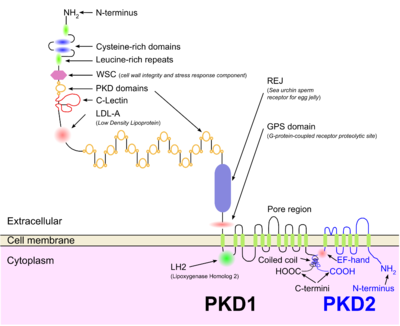Polycystin 2
Ensembl | |||||||||
|---|---|---|---|---|---|---|---|---|---|
| UniProt | |||||||||
| RefSeq (mRNA) | |||||||||
| RefSeq (protein) | |||||||||
| Location (UCSC) | Chr 4: 88.01 – 88.08 Mb | Chr 5: 104.61 – 104.65 Mb | |||||||
| PubMed search | [3] | [4] | |||||||
| View/Edit Human | View/Edit Mouse |
Polycystin-2 (PC2)[5] is a protein that in humans is encoded by the PKD2 gene.[6][7][8]
The gene PKD2 also known as TRPP2, encodes a member of the polycystin protein family, called
calcium homeostasis and other signal transduction pathways. This protein interacts with polycystin 1 (TRPP1) to produce cation-permeable currents. It was discovered by Stefan Somlo at Yale University
.

Clinical significance
Mutations in this gene have been associated with autosomal dominant polycystic kidney disease.[8]
Interactions
Polycystin 2 has been shown to
See also
References
- ^ a b c GRCh38: Ensembl release 89: ENSG00000118762 – Ensembl, May 2017
- ^ a b c GRCm38: Ensembl release 89: ENSMUSG00000034462 – Ensembl, May 2017
- ^ "Human PubMed Reference:". National Center for Biotechnology Information, U.S. National Library of Medicine.
- ^ "Mouse PubMed Reference:". National Center for Biotechnology Information, U.S. National Library of Medicine.
- ^ "PKD2 polycystin 2, transient receptor potential cation channel [Homo sapiens (human)] - Gene - NCBI". www.ncbi.nlm.nih.gov. Retrieved 16 November 2022.
- PMID 8307555.
- S2CID 5634589.
- ^ a b "Entrez Gene: PKD2 polycystic kidney disease 2 (autosomal dominant)".
- ^ PMID 10097141.
- PMID 9192675.
- PMID 12525172.
Further reading
- Islam MS (January 2011). Transient Receptor Potential Channels. Advances in Experimental Medicine and Biology. Vol. 704. Berlin: Springer. p. 700. ISBN 978-94-007-0264-6.
- Torres VE (March 1998). "New insights into polycystic kidney disease and its treatment". Current Opinion in Nephrology and Hypertension. 7 (2): 159–169. S2CID 9719193.
- Deltas CC (2001). "Mutations of the human polycystic kidney disease 2 (PKD2) gene". Human Mutation. 18 (1): 13–24. S2CID 11511861.
- Boletta A, Germino GG (September 2003). "Role of polycystins in renal tubulogenesis". Trends in Cell Biology. 13 (9): 484–492. PMID 12946628.
- Cantiello HF (June 2004). "Regulation of calcium signaling by polycystin-2". American Journal of Physiology. Renal Physiology. 286 (6): F1012–F1029. S2CID 6715458.
- Everson GT, Taylor MR, Doctor RB (October 2004). "Polycystic disease of the liver". Hepatology. 40 (4): 774–782. PMID 15382167.
- Witzgall R (2007). "TRPP2 channel regulation". Transient Receptor Potential (TRP) Channels. Handbook of Experimental Pharmacology. Vol. 179. pp. 363–375. PMID 17217069.
- Köttgen M (August 2007). "TRPP2 and autosomal dominant polycystic kidney disease". Biochimica et Biophysica Acta (BBA) - Molecular Basis of Disease. 1772 (8): 836–850. S2CID 20063435.
- Andersson B, Wentland MA, Ricafrente JY, Liu W, Gibbs RA (April 1996). "A "double adaptor" method for improved shotgun library construction". Analytical Biochemistry. 236 (1): 107–113. PMID 8619474.
- Mochizuki T, Wu G, Hayashi T, Xenophontos SL, Veldhuisen B, Saris JJ, et al. (May 1996). "PKD2, a gene for polycystic kidney disease that encodes an integral membrane protein". Science. 272 (5266): 1339–1342. S2CID 28192819.
- Schneider MC, Rodriguez AM, Nomura H, Zhou J, Morton CC, Reeders ST, Weremowicz S (November 1996). "A gene similar to PKD1 maps to chromosome 4q22: a candidate gene for PKD2". Genomics. 38 (1): 1–4. PMID 8954772.
- Yu W, Andersson B, Worley KC, Muzny DM, Ding Y, Liu W, et al. (April 1997). "Large-scale concatenation cDNA sequencing". Genome Research. 7 (4): 353–358. PMID 9110174.
- Qian F, Germino FJ, Cai Y, Zhang X, Somlo S, Germino GG (June 1997). "PKD1 interacts with PKD2 through a probable coiled-coil domain". Nature Genetics. 16 (2): 179–183. S2CID 32450405.
- Xenophontos S, Constantinides R, Hayashi T, Mochizuki T, Somlo S, Pierides A, Deltas CC (June 1997). "A translation frameshift mutation induced by a cytosine insertion in the polycystic kidney disease 2 gene (PDK2)". Human Molecular Genetics. 6 (6): 949–952. PMID 9175744.
- Tsiokas L, Kim E, Arnould T, Sukhatme VP, Walz G (June 1997). "Homo- and heterodimeric interactions between the gene products of PKD1 and PKD2". Proceedings of the National Academy of Sciences of the United States of America. 94 (13): 6965–6970. PMID 9192675.
- Hayashi T, Mochizuki T, Reynolds DM, Wu G, Cai Y, Somlo S (August 1997). "Characterization of the exon structure of the polycystic kidney disease 2 gene (PKD2)". Genomics. 44 (1): 131–136. PMID 9286709.
- Veldhuisen B, Saris JJ, de Haij S, Hayashi T, Reynolds DM, Mochizuki T, et al. (September 1997). "A spectrum of mutations in the second gene for autosomal dominant polycystic kidney disease (PKD2)". American Journal of Human Genetics. 61 (3): 547–555. PMID 9326320.
- Viribay M, Hayashi T, Tellería D, Mochizuki T, Reynolds DM, Alonso R, et al. (December 1997). "Novel stop and frameshifting mutations in the autosomal dominant polycystic kidney disease 2 (PKD2) gene". Human Genetics. 101 (2): 229–234. S2CID 22047464.
- Pei Y, Wang K, Kasenda M, Paterson AD, Liang Y, Huang E, et al. (May 1998). "A novel frameshift mutation induced by an adenosine insertion in the polycystic kidney disease 2 (PKD2) gene". Kidney International. 53 (5): 1127–1132. PMID 9573526.
External links
- GeneReviews/NIH/NCBI/UW entry on Polycystic Kidney Disease, Autosomal Dominant
- "Transient Receptor Potential Channels: TRPP1". IUPHAR Database of Receptors and Ion Channels. International Union of Basic and Clinical Pharmacology.
